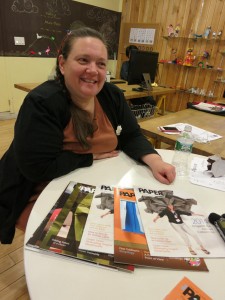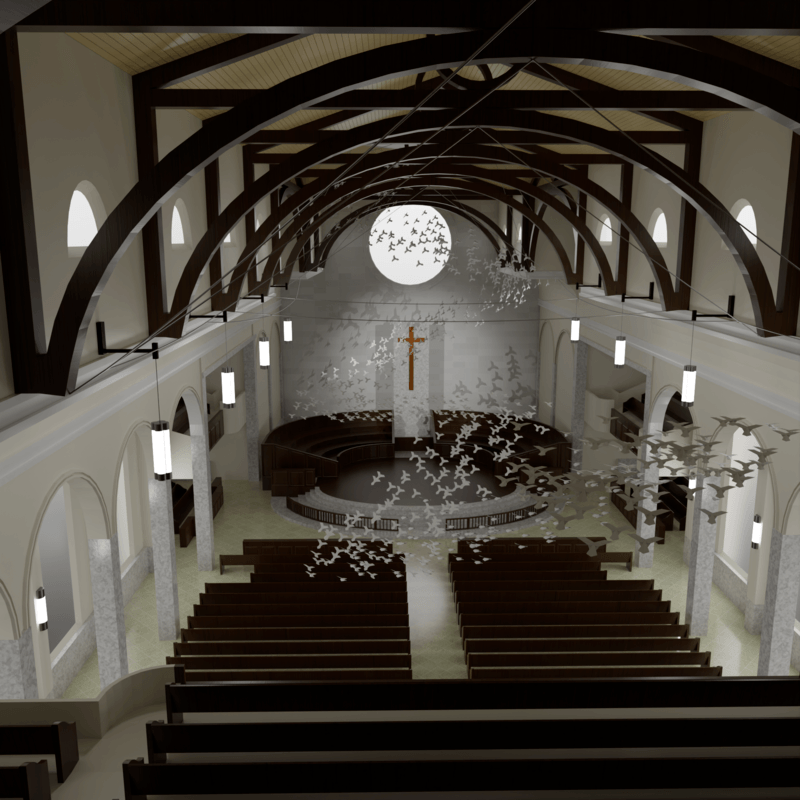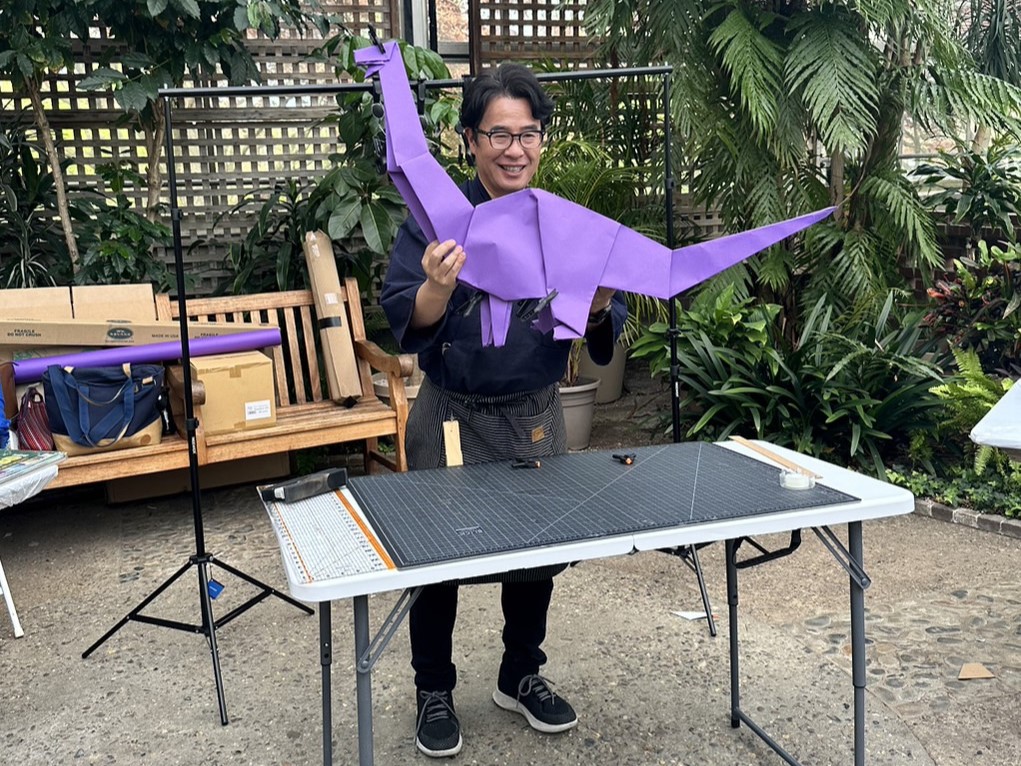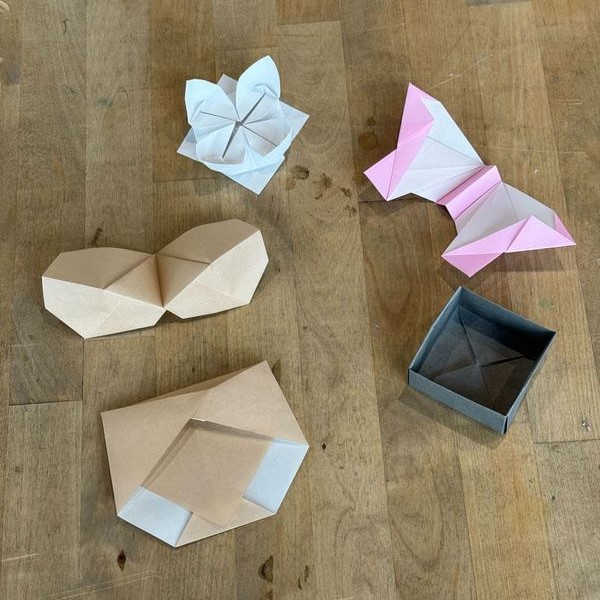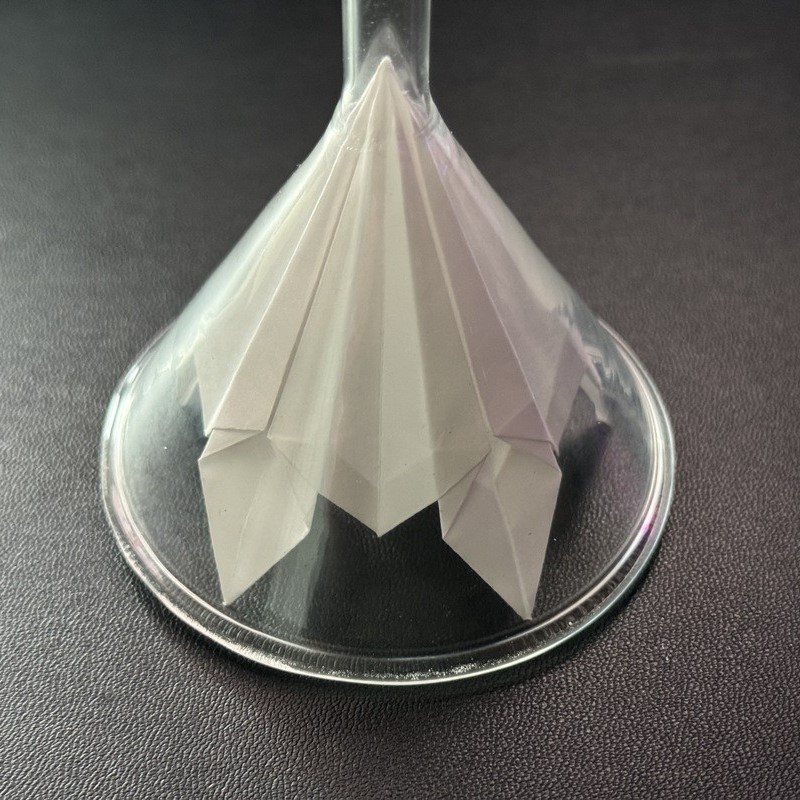Taro’s Origami Studio: How long have you been serving as president of Origami USA?
Wendy Zeichner: I’ve been president of Origami USA since 2008, so seven years.
TOS: Over those seven years have you seen new trends?
WZ: I’ve seen a lot of changes in seven years. During that time, we revamped our whole website. Our website is critical to helping us serve members from all over the world. We’ve added an online magazine. We still have the paper magazine called “The Paper,” a 32-page glossy magazine which comes out three times a year, but we also have an a magazine called “The Fold.” There are six issues of “The Fold” a year, but every two weeks we add new online articles. There are articles and there are diagrams. “The Fold” started in 2012, and in three years we’ve published 150 diagrams. They’re all online, so anyone who joins can have access to those diagrams. We’ve made an online membership available, so people who don’t want any paper in the house (that they’re not folding) can just get the online membership, and they get back issues of “The Fold” and the online PDF of “The Paper,”which is really nice. We have also continued to do our conventions. This year our convention is moving. For the past 20 years it’s been at FIT in Manhattan, and in 2015 it will be at Manhattan College in Riverdale in the Bronx. We’re very excited because it’s still on the subway line (you can take the 1 train to the end) and it’s beautiful. It’s a gorgeous campus. They have a state-of-the-art conference center wired with screens and Wi-Fi across the whole campus, and the dorms are reasonably priced and the food is great and also reasonably priced.
TOS: How many people are at the conventions?
WZ: 650, and that’s just the attendees. We also make it open to the public for the exhibition, and we have a sales area. We’re really looking forward to that.
TOS: How long have the conventions been happening?
WZ: Conventions date back really far. There were early conventions happening at the home of Lillian Oppenheimer, who is one of our founders. She had conventions of around 50 people in her house in the 1960’s. Origami USA was incorporated as a non-profit in 1980, and we definitely had conventions going back all the way to then. Our early conventions were at the Museum of Natural History where we have our offices. In the late ’80s, maybe 1988 or ’89, we moved to a middle school on Columbus Avenue and 77th Street catty-corner to the museum, IS 44. We were at the middle school until the mid-90’s. In 1993 we moved to FIT, and then we had conventions there all the way until 2014. Now we’ve got a new venue, and we’re really excited about that.
TOS: How did you come to origami and to Origami USA?
WZ: Back in 1987, I went to Epcot Center in Disney World, and they had a Japanese pavilion there. I bought a pack of diagonal striped kami (I’d never seen kami that was shaded, I had only seen plain kami) and a Christmas origami book as a gift for a friend of mine. She had seen the tree at the museum and wanted to make ornaments for her tree. That night in the hotel I thought, “Oh, she won’t notice if one paper is missing.” By the end of the night I folded everything in the book, most of the paper was gone, and the next day we went back to Epcot just to buy more origami paper because I had to give it to my friend. I gave it to her, and a week later she gave it back to me and said, “I can’t do this, could you do it for me?” In the front of the book, there was a forward by Lillian Oppenheimer, and she had already called Lillian and bought some foil paper from her. So she gave me everything. I called Lillian and she said, “Well, you’ve got to call the museum.” Then Michael Shall answered, and I said I want to join Origami USA. He said, “All right, I’ll send you some information,” and I said, “No, I’m coming up there.” I came up to the office, showed him all the models I had folded, and joined on the spot. A year later I was on the board. I was on the board for about three years. My kids were little so I had to take care of them, I had a full-time job, a husband, and a house. I joined the board again in 2000 and became president in 2008. That’s the story.
TOS: What books and artists are you particularly into?
WZ: I’ve been a longtime fan of Tomoko Fuse. At one point I had all her books, but now she’s got way too many books for me to have all of them. I met Tomoko Fuse in 1990. She was a special guest at our convention and Michael Shall arranged for her to stay at my house. So she did, and over the years we’ve been in touch on and off. We see each other at conventions, and in 2014 she was a special guest at the Centerfold Conference in Ohio, so I went and I saw her there. Then I went to Japan to 6OSME (6th International Meeting on Origami in Science, Mathematics and Education) and then the JOAS (Japanese Origami Academic Society) Tantedian Convention, and she was at both of those. We hung out a lot and I did an interview for the magazine that’s coming out in about two weeks. I like modulars a lot. I fold Paolo Bascetta’s module a lot, it’s an easy go-to model for me. I like to fold Spring into Acting by Jeff Benyon. I’ll fold animals but usually it’s just a one-off. I’ll come to a class and I’ll really enjoy the process of folding it, but I won’t feel compelled when it comes to animals to really memorize. I really enjoy simple models, because they’re so available to teach to people. I do a lot of teaching at the museum. We have that large Christmas tree every year and around the tree we have teaching tables. We’ll have a table with a teacher and some paper and anyone who comes by the museum can stop by and learn a model. I’ve been teaching classes to museum volunteers so they can teach at the teaching tables. I teach those about three times a year to refresh and replenish the number of volunteers that we have.
TOS: What do you teach them?
WZ: What’s interesting is that I’m not just teaching them models, I’m teaching them how to teach the models. These are people who have never folded. I have them make the model four times: The first time, I teach it and they don’t fold. They watch me teach it, and I tell them to pay attention to what I’m saying, the terminology I’m using, and the tips as I move through the models. I say things like, “Now it looks like a house, now it looks like a mountain, now it looks like a heart.” Second, I teach it and they fold with me. That’s interesting because they kind of know what’s coming because they’ve seen it. Then I have them get into pairs and they teach each other, or sometimes the fourth step is they’ll teach it by themselves and then they’ll teach each other. Then, I give out diagrams and the verbiage that I’m using, because a lot of diagrams don’t have verbiage that says, “White side up, turn the paper over,” and that helps them to learn to read the diagrams. I usually teach a three-hour class, and we only do maybe four or five models, and this way they know them, and when they teach it to the public they’ve got this little repertoire of models. Since I teach it like two to three times a year, I’ll teach a set of models at Christmas-time, so that they’re prepared to teach by the tree. I’ll do the candy cane and the Christmas tree. I almost always teach the swan. I’ll teach a sailboat from a triangle, and that’s a model that’s so simple that even three-year olds can do it. A lot of the kids who come to the museum are little, so they’ll just stop by and do one or two folds. I’ll teach another set of models for spring. Just before the February break I taught heart models. I try to make it seasonal. I’ve taught jumping frog out of index cards. There’s a snake model which the kids really like because they’re in the museum, and it’s an animal, and we have a snakeskin pattern that we xerox onto 8 1/2 X 11 paper. We’ll teach whirligigs, and it’s nice because it’s an action model but it’s not an airplane. I really enjoy the simple models because they’re so portable. The slogan of Origami USA is “Origami is for anyone, anywhere, anytime.” Michael Shall used to say that, and we’ve adopted that as our slogan. It’s on the front page of our website, it’s on the back of my business card, and when I went to Japan, I learned to say it in Japanese!
TOS: How long were you in Japan?
WZ: I was in Japan for 15 days last time, and I also went to Korea. The KOA had a convention, and I got to fold with two Korean groups.
TOS: Is Origami USA in touch with a lot of origami organizations around the world?
WZ: We try to be. I’m hoping to go to Spain at the end of April for a convention in Barcelona because I want to see the origami Museum in Zaragoza. When I was in Japan the last time, I went to the origami museum that’s run by the NOA in the Kaga Onsen province where the hot springs are.
TOS: In different places around the world, do you see different styles of folding?
WZ: It’s really interesting, because when you go to these conventions and you’re taking classes and you’re with people, you don’t speak the same language as them, but it really doesn’t matter. When you’re in the class and you’re all folding, it transcends language. It’s a magical feeling to just be folding with people. You’re not just folding and learning from a teacher who isn’t speaking your language, but you’re helping people sitting next to you, or they’re helping you, and you don’t speak the language. When I was in Korea, they didn’t speak Korean, they didn’t speak English, I didn’t speak whatever language they spoke. It didn’t matter. It transcends that and creates a nice “peace of paper” feeling. For me, that’s the highlight of experiencing these conventions all over the world. What’s actually surprising is that a lot of the techniques and ways of folding are the same. It’s a really global community. Anywhere I can think of traveling I know there are origami people that I can meet, that I can fold with, that I can stay with, and that’s really cool!
TOS: Are there you seeing trends in the artistry?
WZ: Origami has really come a long way since the the 60’s. Using computers to do design work, like Robert Lang’s circle-river packing methods that show the crease patterns and how the paper is used. In the next issue of “The Paper,” Beth Johnson wrote a great article on how to read a crease pattern and how to take a crease pattern and turn it into a model, because a lot of people find the crease pattern kind of intimidating. I really love the tessellation work that I’ve seen. Eric Gjerde’s book on tessellations is wonderful. The stuff that Beth Johnson has done, she’s got a sheep model that combines tessellations and representational animals. The sheep’s wool is tessellation and the body is an animal, and you drape the tessellation over the sheep, and it’s really nice. There’s been great advances in modular origami, box making, wet-folding. Michael LaFosse and Richard Alexander make their own paper and then fold it, they’ve given many tutorials and classes on explaining that.
TOS: Is that based on traditional Japanese washi paper, or it’s their own thing?
WZ: It’s their own thing. They have a book that describes the recipes they use. I think a lot of paper that’s made for origami is made from banana leaf pulp, and so they’ve developed a paper that’s very, very strong and very, very thin, and that allows you to do complex models.
TOS: You don’t have to worry about the paper ripping.
WZ: The ripping, the layers that build up, especially if you’ve got a box-pleated model. I find that really interesting. My favorite edition of this magazine talks through a lot of the scientific breakthroughs that are being made from origami. You’ve got airbags, satellite solar panels, medical stints, and self-folding origami where you’ve got electrodes built into some sort of material. The pinwheel base on the cover is a flat sheet that’s made out of these triangle shapes with magnets and circuitry built into them, and you send it a program that says “Fold yourself.”
I feel origami is the key to a lot of scientific breakthroughs, because really everything is folded. At the beginning of “Between the Folds,” Paul Jackson, who I also know and I love his models, says how everything folds: Your eyelids fold, your clothes fold where we crease them, the air is folding as I’m talking to you, and even your DNA is folded. In that movie, he says we are born from folding. To me, that’s an amazing image, because if you think about it, babies are folded up inside their mothers, and when they’re born they unfold. Flowers, when they close, they fold up, and then they unfold. All of nature has folding in it, and the mathematical algorithms that come out of the work of people like Robert Lang and Erik Demaine, where they’re understanding how things fold, why things fold, really lends itself to discovery.
They talk a lot about STEM education – Science, Technology, Engineering, Math – but really, it’s more than that. It’s art and design, and they’re all intertwined with each other. Origami is the perfect representation of that juxtaposition where all of those things come together. I’m sure that’s probably the case with other things like music or other art, but origami is something that’s tangible. That really makes an impact, the fact that you can start with very simple models. There’s a young girl, she’s like ten years old, and her parents were in the museum with her. They saw the tree, they saw the table, they learned a few models, they called up the origami office, and they stopped by. Now she’s folding constantly – complex models! She’ll probably be designing her own stuff soon. She goes to the Folding Sundays, she goes to the special sessions classes we have, she goes to the OMG (Origami Meetup Group) that’s run by Sok Song, and it’s really opened up a whole world for her. For a lot of kids, origami is life-changing.
Interviewed by Jeff Raab


